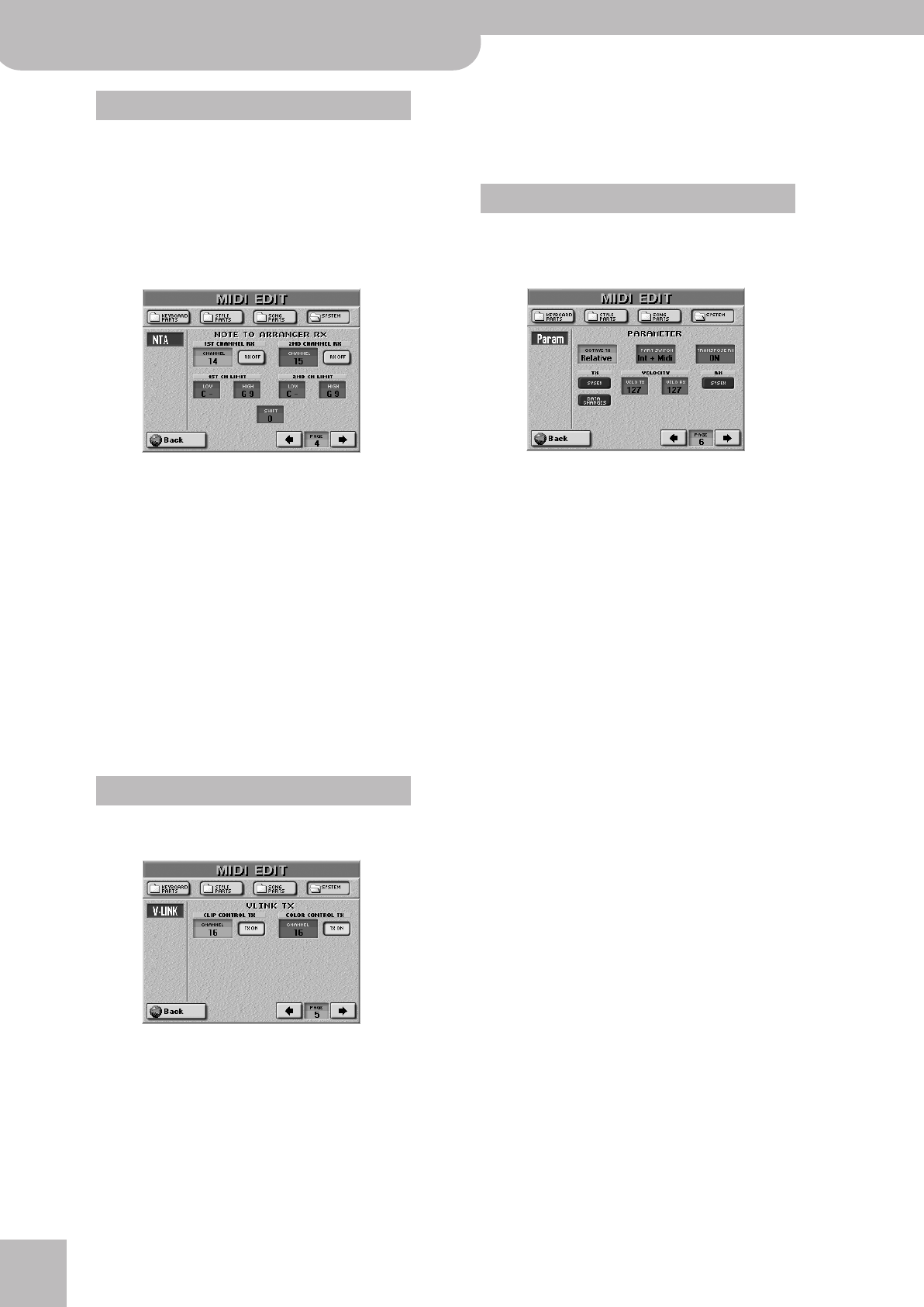
MIDI
192
r
E-60/E-50 Music Workstation
NTA notes are only received (from an external MIDI
instrument). What you play in the chord recognition
area of the keyboard to feed the Arranger is auto-
matically converted to the corresponding MIDI note
numbers, so that all Style parts transmit their notes
to external instruments. There is thus no need to
transmit the note messages of what you play in the
chord recognition area (NTA) separately.
■1ST CHANNEL RX/2ND CHANNEL RX
● CHANNEL—NTA notes can be received on two MIDI
channels, so that you could control the E-60/E-50’s
Arranger using a MIDIfied accordion (FR-7 or FR-5) or
any other instrument that sends note data on two chan-
nels. Either channel can be switched off using its
[ON÷OFF] field.
Note: You cannot assign the same MIDI channel to 1 & 2
Channel Rx.
■1ST CH LIMIT, 2ND CH LIMIT (C-~G9)
These parameters allow you to set the note range to be
received. If not all note messages of the selected MIDI
channel should be received by the NTA “part”, set the range
to the desired values.
Note: The LOW LIMIT value cannot be higher value than HIGH
LIMIT (and vice versa).
When you select “V-LINK” on the [SYSTEM] page, the
display changes to:
Here, you can only set TX parameters (because the
E-60/E-50 only sends V-LINK messages—it does not
receive them). See page 195 for details about the V-
LINK functionality.
● CLIP CONTROL TX—This parameter allows you to set the
MIDI channel (CHANNEL) to be used for the transmission
of these messages. Use the [ON/OFF] field to enable
(lights) or disable (dark) transmission.
● COLOR CONTROL TX—This parameter allows you to set
the MIDI channel (CHANNEL) to be used for the trans-
mission of these messages. Use the [ON÷OFF] field to
enable (lights) or disable (dark) transmission.
This page contains several parameters that are not
related to one another (the other MIDI pages always
concentrate on one aspect).
■PARAMETER
● OCTAVE TX—The OCTAVE TX parameter can be set to
Absolute or Relative. You may have noticed that if you
assign a bass sound to the UP1/2 part in SPLIT mode, the
notes are transposed to allow you to play meaningful
bass lines using the UP1/2 part. “Relative” means that
this internal (and automatic) transposition is translated
into MIDI note numbers.
In “Absolute” mode, however, the MIDI note numbers
sent to other instruments will be the ones of the keys
you actually press.
● PART SWITCH—This parameter allows you to specify
whether or not a muted part should go on sending MIDI
messages:
● TRANSPOSE RX (On/Off)—Use this parameter to spec-
ify whether note messages received via MIDI should be
transposed.
■VELOCITY
● VELO TX, VELO RX (On, 1~127)—Your E-60/E-50 is
equipped with a velocity-sensitive keyboard and a tone
generator capable of responding to velocity messages.
Use the fields to switch the reception (RX) or transmis-
sion (TX) of velocity messages on or off.
If you don’t select “On”, specify which velocity value to
use instead of the continuous flux. The value you set will
be used for all notes received via MIDI IN/USB (RX) or
sent to MIDI OUT/USB (TX).
■TX
● SYSEX—Use this parameter to specify whether (button
icon on) or not (off) the E-60/E-50 should send SysEx
messages. Such messages are not standardized, so that
each manufacturer can use them ad lib for temporary (or
NTA: Note-to-Arranger
If you select the V-Link part
PARAM
Internal:
A muted part can no longer be played via the E-60/
E-50’s keyboard or Arranger/Recorder but continues
to send MIDI messages. Selecting “Internal” and
muting a part thus has the same effect as selecting
“Local Off” (see p. 189).
Int+Mid:
A muted part can no longer be played via the E-60/
E-50’s keyboard or Arranger/Recorder and no longer
sends MIDI messages.
E-60_50_OM_UK.book Page 192 Thursday, June 22, 2006 10:06 AM


















